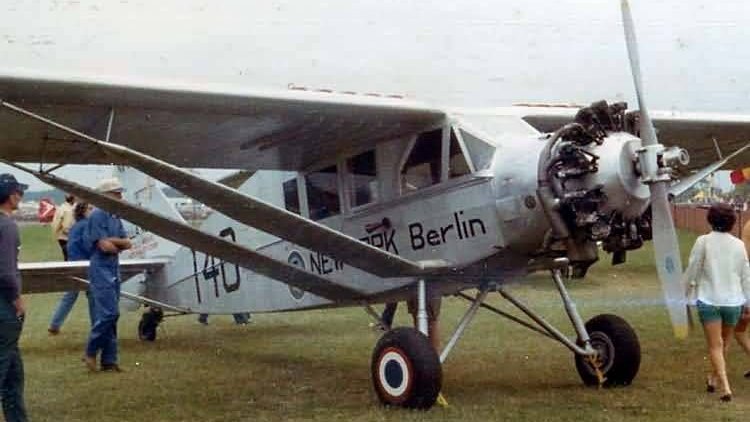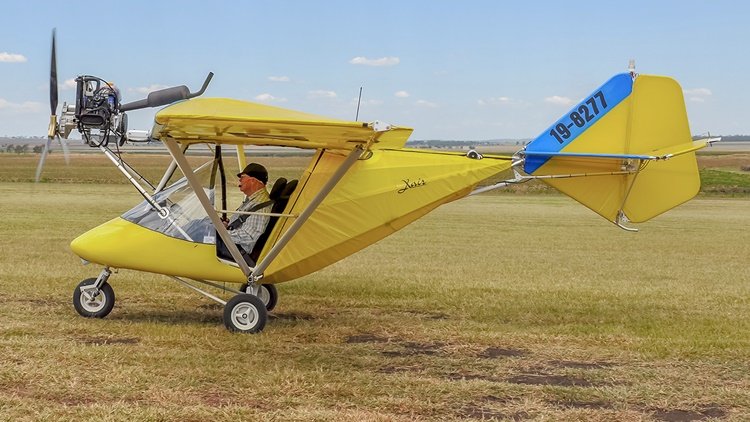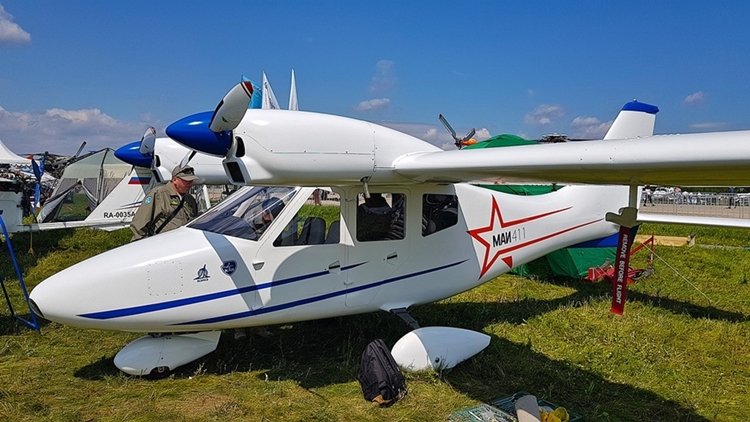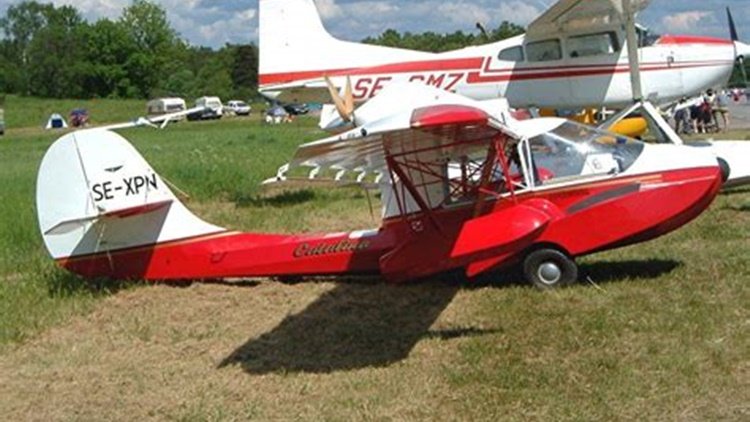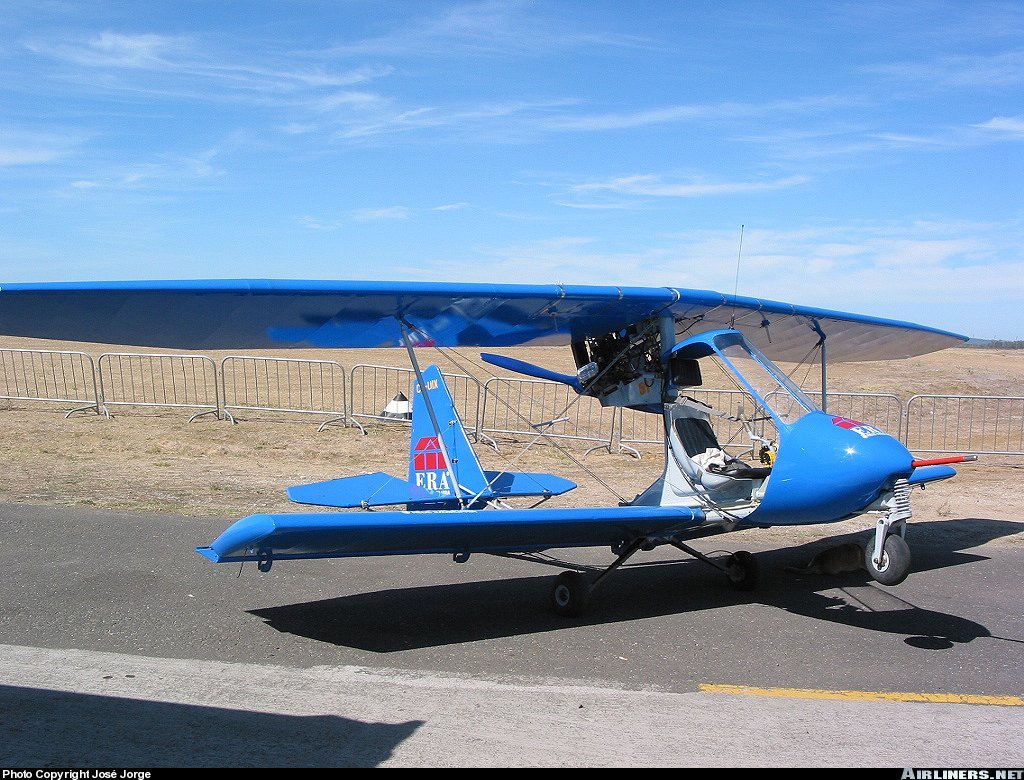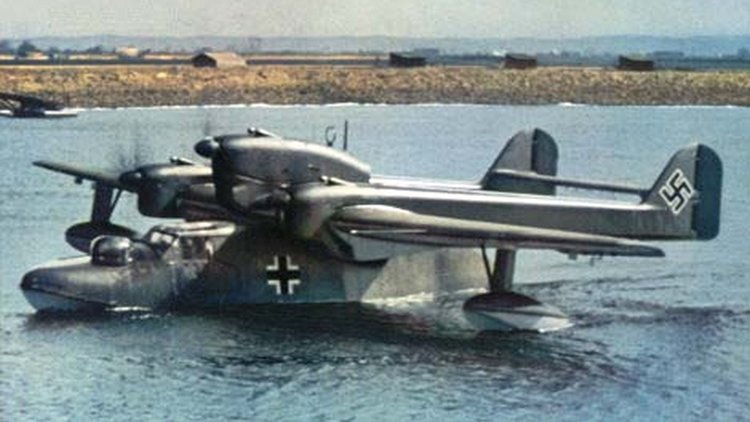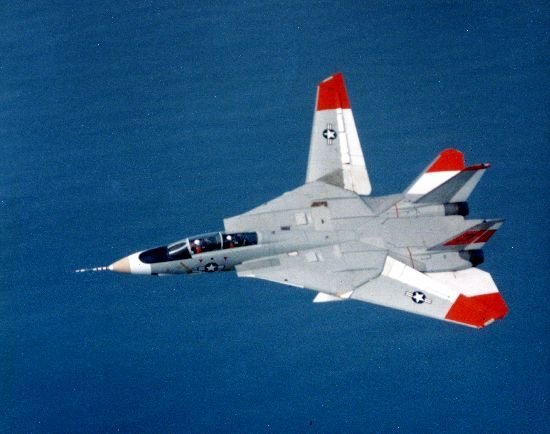-
Posts
7,562 -
Joined
-
Last visited
-
Days Won
67
Content Type
Profiles
Forums
Gallery
Downloads
Blogs
Events
Store
Aircraft
Resources
Tutorials
Articles
Classifieds
Movies
Books
Community Map
Quizzes
Videos Directory
Everything posted by red750
-
Check out this link. Scroll down to the text and read the aircraft generic version.
-
Farman F.4X F-AHAF
-
The Bellanca CH-400 Skyrocket is a six-seat utility aircraft built in the United States in the 1930s, a continuation of the design lineage that had started with the Bellanca WB-2. Retaining the same basic airframe of the preceding CH-200 and CH-300, the CH-400 was fitted with a more powerful Pratt & Whitney Wasp radial engine. Three examples were purchased by the U.S. Navy under the designation RE. Two were used for radio research, and one as an air ambulance for the U.S. Marine Corps. This latter aircraft was reconfigured to carry two stretchers. The aircraft was also available in a deluxe version for private pilot owners, fitted with a more powerful Wasp variant providing 450 hp (336 kW) and detail enhancements. Two of these aircraft were purchased by the government of the Dominion of Newfoundland in 1937, and one later ended in private hands. NC10294 was changed to VO-BCD and NC13155 to VO-BDF. Variants CH-400 (Specifiations below) Six-seat utility aircraft., powered by a Pratt & Whitney Wasp radial piston engine. XRE-1 One aircraft used for radio research work at Naval Air Station Anacostia. XRE-2 One light transport aircraft for the US Navy. XRE-3 One two-stretcher air ambulance aircraft for the US Marine Corps.
-
-
The Bellanca Aircruiser and Airbus were high-wing, single-engine aircraft built by Bellanca Aircraft Corporation of New Castle, Delaware. The aircraft was built as a "workhorse" intended for use as a passenger or cargo aircraft. It was available with wheels, floats or skis. The aircraft was powered by either a Wright Cyclone or Pratt and Whitney Hornet engine. The Airbus and Aircruiser served as both commercial and military transports. The first Bellanca Airbus was built in 1930 as the P-100. An efficient design, it was capable of carrying 12 to 14 passengers depending on the cabin interior configuration, with later versions carrying up to 15. In 1931, test pilot George Haldeman flew the P-100 a distance of 4,400 miles in a time aloft of 35 hours. Although efficient, with a cost per mile figure of eight cents per mile calculated for that flight, the first Airbus did not sell due to its water-cooled engine. The next model, the P-200 Airbus, was powered by a larger, more reliable air-cooled engine. One version (P-200-A) came with floats and operated as a ferry service in New York City, flying between Wall Street and the East River. Other versions included a P-200 Deluxe model, with custom interiors and seating for nine. The P-300 was designed to carry 15 passengers. The final model, the "Aircruiser," was the most efficient aircraft of its day, and would rank high amongst all aircraft designs. With a Wright Cyclone air-cooled supercharged radial engine rated at 715 hp, the Aircruiser could carry a useful load greater than its empty weight. In the mid-1930s, the Aircruiser could carry 4,000 lb payloads at a speed of between 145 and 155 mph, a performance that multi-engine Fokkers and Ford Trimotors could not come close to matching. In 1934, United States federal regulations prohibited single-engine transports on United States airlines, virtually eliminating future markets for the Aircruiser. Where the workhorse capabilities of the Aircruiser stood out was in Canada. Several of "The Flying Ws", as it was commonly dubbed in Canada, were used in northern mining operations, ferrying ore, supplies and the occasional passenger, into the 1970s. Variants Airbus Bellanca P Commercial version of Bellanca K, powered by a 500 hp (370 kW) Pratt & Whitney R-1860 Hornet.[2] P-100 Airbus 14-passenger monoplane powered by a 600 hp (450 kW) Curtiss Conqueror engine, one built, later converted into a P-200. P-200 Airbus 12-passenger monoplane, nine built and one converted from P-100. P-300 Airbus 15-seater monoplane powered by a Wright R-1820 Cyclone engine. Y1C-27 United States Army Air Corps designation for four P-200 Airbuses powered by 550 hp (410 kW) Pratt & Whitney R-1860 Hornet B engine. All later converted to C-27C. C-27A Airbus Production version of the Y1C-27 powered by a 650 hp (480 kW) Pratt & Whitney R-1860 Hornet B engine, ten built. One converted to a C-27B the rest converted to C-27Cs. C-27B Airbus One C-27A re-engined with a 675 hp (503 kW) Wright R-1820-17 Cyclone engine. C-27C Airbus Four Y1C-27s and nine of the C-27A re-engined with a 750 hp (560 kW) Wright R-1820-25 Cyclone engine. Aircruiser Aircruiser 66-67 Improved structure modified from a P-200 with a 675 hp (503 kW) Wright SR-1820 Cyclone engine Aircruiser 66-70 (Specifications below) An Aircruiser with a 710 hp (530 kW) Wright SGR-1820 Cyclone engine, five built - exported to Canada. Aircruiser 66-75 An Aircruiser with a 730 hp (540 kW) Wright Cyclone engine, three built. Aircruiser 66-76 A cargo-version of the Aircruiser with a 760 hp (570 kW) Wright Cyclone. Aircruiser 66-80 An Aircruiser with an 850 hp (630 kW) Wright Cyclone engine.
-
The Beagle A.61 Terrier is a British single-engined monoplane built by Beagle Aircraft. The Auster Aircraft Company purchased a large number of former British Army Auster aircraft during the late 1950s. These were Auster AOP.6, T.7 and T.10 aircraft which were updated and modified with de Havilland Gipsy Major 10-1-1 engines. Initially two versions were offered for sale in the civilian market from 1960: Auster 6A Tugmaster – a utility and glider towing aircraft Auster 6B – a three-seat luxury version. When the company became part of Beagle Aircraft. In 1960, the Auster 6B was renamed the Beagle A.61 Terrier 1. In 1962 the Beagle A.61 Terrier 2 was introduced with a greater span tailplane, wheel spats and a metal propeller. The Terrier was not an economic success for the manufacturer as it was found that more man-hours were spent on rebuilding each aircraft after its military use than were spent in building the new aircraft for the Army. It was also out-dated as, by 1961, most competing manufacturers were introducing new designs which were all-metal, with tricycle undercarriages and powered by more modern engines such as Lycoming or Continental (e.g. the Cessna 150 and the Piper Cherokee). However the Terrier has found many adherents among vintage light aircraft owner pilots. Examples of the type were purchased by owners in the United Kingdom, Eire, Germany, Netherlands, New Zealand and Sweden. 23 Terriers were registered in the UK in 2013. Production Terrier 1 Eighteen Terrier 1 conversions were built. The first conversion flew 13 April 1961 from Rearsby. Terrier 2 (Specifications below) Forty-Five Terrier 2 conversions were completed at Rearsby. A small number of airframes were converted subsequently to this standard by other companies. Terrier 3 One Terrier 3 powered by a 160 hp Lycoming O-320-B2B engine was essentially complete at Rearsby when Terrier production was stopped in 1966. In 1967, an incomplete Terrier 2 was modified to this standard by British European Airways engineering apprentices and registered G-AVYK.
-
The Raj Hamsa X-Air is an Indian, two-seat, high-wing, tricycle gear, tractor configuration, ultralight aircraft produced by Raj Hamsa Ultralights of Bangalore, Karnataka in kit form, for amateur construction. The X-Air started as a development of the Chotia Weedhopper redesigned to incorporate ailerons and an enclosed cabin. After initial production in Europe manufacturing was shifted to Raj Hamsa in India. In many countries the aircraft is known as the Rand Kar X-Air. In the USA it is sometimes referred to as the Light Wing X-Air. The aircraft was later developed into the more conventional X-Air Hanuman, which relocated the engine from the upper keel tube to the nose. The X-Air is built from bolted aluminium tubing, mated to a central welded steel cockpit cage. The wings and tail surfaces are covered in pre-sewn Dacron sailcloth envelopes. The aircraft is built around its keel, a large tube that runs from the high-mounted engine in the front to the tail in the back. The wings are supported by V-struts with jury struts. The landing gear incorporates oleo shock absorbers on all three wheels. The nosewheel is steerable and mainwheel brakes are standard. Dual controls are standard, but cockpit doors are optional. The cockpit has been criticized by reviewer Andre Cliche as "a bit difficult to access". The X-Air can be fitted with either floats or skis. Engines from 50 to 75 hp (37 to 56 kW) can be fitted, provided they weigh under 120 lb (54 kg). The construction time is estimated at 40 hours. Due to its low price and BCAR Section "S" certification the X-Air has proven popular in the United Kingdom. An X-Air has been used as a testbed for the prototype D-Motor LF26 flathead engine. Variants X-Air "S" (Standard) Specifications below. Initial version, certified under UK BCAR Section "S" as a microlight. Standard engine is the 64 hp (48 kW) Rotax 582 and the 80 hp (60 kW) Rotax 912UL, 85 hp (63 kW) Jabiru 2200 and the 60 hp (45 kW) HKS 700E four-stroke powerplants are also used. The design is popular in the UK, especially with the Jabiru engine. X-Air "F" Gumnam Improved version, aerodynamically cleaned up, extended fuselage with baggage compartment, Lexan doors and wheel pants are standard. The wing is 1 m (39 in) shorter, with a higher aspect ratio, 100% double surface, flaps and a NACA 4412 airfoil. Certified under UK BCAR Section "S" as a microlight and marketed in the UK as the X-Air Falcon. Standard engine is the 64 hp (48 kW) Rotax 582, although the 50 hp (37 kW) Rotax 503 or 85 hp (63 kW) Jabiru 2200 four-stroke engine can be used. X-Air "H" Hanuman See separate profile Development version, with nose-mounted 85 hp (63 kW) Jabiru 2200 four-stroke engine.
-
The Columbia XJL is a large single-engined amphibious aircraft designed by Grumman Aircraft but built by the Columbia Aircraft Corp. It was intended to replace the Grumman J2F Duck but the type did not reach production status. Only 3 examples were built. The Grumman J2F Duck biplane amphibian had successfully served the United States Navy (USN) in quantity from late 1934 onwards. The final 330 examples were built in 1941/42 under sub-contract by the Columbia Aircraft Corp, retaining the J2F-6 designation. At the end of World War II, Grumman completed a major re-design of the aircraft for the USN as a Wright R-1820-56 powered monoplane amphibian. The new design was turned over to the Columbia Aircraft Corporation for development and construction so that Grumman could focus on the production of fighter aircraft for the USN. The aircraft strongly resembles the J2F Duck, except for its monoplane layout, and has been referred to as a "single-winged Duck". It is, however, a completely new design.
-
Moscow Aviation Institute (National Research University) (MAI; Russian: Московский авиационный институт, МАИ) is one of the major engineering institutes in Moscow, Russia. They have developed, or are developing, a range of general aviation aircraft. MAI-411 multi-purpose four-seat twin engine airplane has been designed according to AP—23 Aviation Rule requirements, analog of European CS—23 and American FAR—23. The following description is taken from the manufacturers website. Refer to this website for details of the other models by this manufacturer. The airplane is equipped with modern all-digital navigation complex for easy and safe flight operations in all operation modes. The standard crew and passenger seating is side-by-side in two rows. The cabin height is 1220 mm, crew and passenger seating area width is 1275 mm, which provides comfortable conditions of housing the people dressed in winter clothes. The cabin has ventilation and heating systems efficient within the whole range of operating conditions (-25...+40˚C). The luggage section is located behind the backs of the 2nd row seats. A vertical tail includes a fin integrated with a fuselage, and a rudder. A horizontal tail comprises a cantilever stabilizer and an elevator. Both stabilizer and an elevator are made one-piece tailplane by span, which lowers the weight and improves efficiency. Airplane have a tricycle landing gear with a nose wheel. The airplane has an ability of a float-type and ski landing gear mounted. A power plant includes two ROTAX 912S piston engines closed in engine nacelles and located on the wing symmetrically to the fuselage. The main fuel tanks are in the center-wing section. The airplane is of a double control. A pilot's seat is on the left.
-

Odd aircraft depicted on TV documentary
red750 replied to red750's topic in Aircraft General Discussion
That's what I said. The photo in my post was of a B-52. -
I was watching a TV story on Japan Air Lines Cargo Flight 1628 sighting of an unidentified flying object on November 17, 1986 by a Japanese Boeing 747-200F cargo aircraft flying from Paris to Narita International Airport, near Tokyo. During the flight over the Alaska triangle, Captain Kenji Terauchi reported seeing three objects he described as "two small ships and the mother ship". The incident is covered in Wikipedia. The show depicted a 747 fuselage and wings, with four engines, mounted one pair per wing, similar the the engine arrangement on a B-52. I am unable to locate any information or photo of such an aircraft.
-
-
The Avid Catalina is an American homebuilt amphibious aircraft that was designed and produced by Avid Aircraft of Caldwell, Idaho. It is a development of the Avid Amphibian. When it was available the aircraft was supplied as a kit, for amateur construction. The Catalina was introduced in September 1994. Avid Aircraft ceased operations in November 2003 and Catalina production ended. The Catalina features a strut-braced high-wing, a three-seat enclosed cabin, retractable conventional landing gear, a boat hull and a single engine in pusher configuration. The aircraft is made from mixed construction, consisting of welded steel tubing, with its flying surfaces covered in doped aircraft fabric, plus fiberglass for the hull and other parts. Its 36.00 ft (11.0 m) span wing has a wing area of 150.00 sq ft (13.935 sq m) and folds for storage or ground transport, without disconnecting the controls. The wing is supported by "V" lift struts with jury struts. The Catalina wings had the option of mid-wing sponsons, or the original Amphibian droop wing tip sponsons for water operations. The original engine used was the 64 hp (48 kW) Rotax 582 twin cylinder two stroke powerplant. Other known engines flown have included the Rotax 618, Rotax 912,[8] Hirth F30,[9] Hirth 2706 and Verner 133MK engines. The Catalina has an empty weight of 600 lb (270 kg) and a gross weight of 1,200 lb (540 kg), giving a useful load of 600 lb (270 kg). With full fuel of 17.5 U.S. gallons (66 L; 14.6 imp gal) the payload is 495 lb (225 kg). While the 17.5 U.S. gallons (66 L; 14.6 imp gal) fuel tank is standard equipment, the factory also offered optional 31.5 U.S. gallons (119 L; 26.2 imp gal) and 45.5 U.S. gallons (172 L; 37.9 imp gal) tanks. The earlier Amphibian model offered only 17.5 U.S. gallons (66 L; 14.6 imp gal) standard fuel, with a total of 28 U.S. gallons (110 L; 23 imp gal) as two 14 U.S. gallons (53 L; 12 imp gal) tanks optional. The Avid Amphibian and Catalina could also be built without water operations capability. This variation of the aircraft was dubbed the "Landphibian", and was lighter without the inboard and outboard sponsons. In 1992 the Amphibian kit cost US$16,695, while the land-only version kit was US$15,695. The manufacturer estimated the construction time from the supplied kit as 700 hours. By 2001 the company reported that 100 examples of the Amphibian/Catalina were flying. Variants Amphibian Earlier version with turned down wingtips acting as tip floats Catalina Later version introduced in September 1994, with conventional wing-mounted floats. Landphibian Version with float gear removed.
-
The Aviatika-MAI-890 is a pod-and-boom, pusher configuration biplane ultralight designed and built by the Moscow Aviation Institute (MAI) in Russia in the 1980s. As well as being a sport and training aircraft, significant numbers have been used for agricultural spraying. It remained in production in 2015. The MAI-890 design originated and was developed by the Experimental Aircraft design section, known as OSKBES, of the School of Aeronautics at the MAI. From about 1990 the MAI design bureau became part of the Aviatika joint-stock company to facilitate aircraft production, so that for much of the 1990s the 890 was an Aviatika product. In 1998 MAI acquired the production rights from Aviatika and marketed it as the Aviatika-MAI-890. The starting point was the open cockpit, short span Junior which appeared in 1987 and developed into the full-span, enclosed seat prototype MAI-89 in 1989. The production prototype, designated MAI-890, followed the next year and production began in 1991. Since then two seat and agricultural versions have been produced. The MAI-890 has a structure of mixed aluminium, titanium and steel alloys and is fabric covered. It is an unequal span biplane with a straight lower wing of constant chord and some dihedral, which carries full span ailerons. The upper wing has greater span, some sweep but no dihedral, with constant chord over much of its span but with taper on the outer panels. It is a single bay biplane with one, slender interplane strut on each side assisted by flying wires; at its centre, the upper wing is fixed to the underwing engine mounting. Enclosed single or side-by-side seating is positioned ahead of the lower wing leading edge. A slender boom from the bottom of the fuselage pod carries the empennage; all tail surfaces are straight edged and strongly tapered and have generous control areas, with ground-adjustable trim tabs on the elevators. All current MAI-890 are powered by Rotax engines mounted in pusher configuration, the type depending on the aircraft variant and option. It has a short-legged, fixed tricycle undercarriage with cantilever main legs attached the boom behind the cabin. More than 300 aircraft were reported sold by 2006, about 60 of them agricultural variants, about 30 exported to South Africa.[4] 26 MAI-89s and -890s appeared in the civil aircraft registers of European countries outside Russia in mid-2010. Variants Junior Open cockpit single seater with short span (5.68 m; 18 ft 7.5 in); maximum take-off weight (MTOW) 282 kg (617 lb). First flew July 1987. MAI-89 longer span (8.11 m; 26 ft 7.5 in); MTOW 340 kg (750 lb). Flown 1989. MAI-890 Production version, flown 1990 and produced from 1991 with interruption in mid-1990s but with a 2002 statement that production continued. Single seater. MAI-890U Two side-by-side seats. First flown August 1991 with 48 kW (64 hp) Rotax 582 UL engine; standard engine, first flown 16 September 1992, is the Rotax 912 UL. MTOW 540 kg (1,190 lb). Floatplane version tested 2000. Aviatika-MAI-890SKh Farmer Single seat, MAI-890 based, Rotax 912 ULS or Rotax 582 powered crop-spraying version, with a spraybar aft of the lower wing s fed from a tank below the engine.[1] Aviatika-MAI-890USKh (Specifications below) Two seat, MAI-890U based crop-spraying version.[1] Aviatika-MAI-890S South African designation of prototype converted to Rotax 912 ULS; in Russian terms a MAI-890. 980U Mai South African name for MAI-890U. 980CSH Mai South African name for agricultural version.
-
The Blohm & Voss BV 138 Seedrache (Sea Dragon), but nicknamed Der Fliegende Holzschuh ("flying clog", from the side-view shape of its fuselage, as well as a play on the title of the Wagner opera 'Der fliegende Holländer' or 'The Flying Dutchman') was a World War II German trimotor flying boat that served as the Luftwaffe's main seaborne long-range maritime patrol and naval reconnaissance aircraft. A total of 297 BV 138s were built between 1938 and 1943. Originally developed under the company name of Hamburger Flugzeugbau, the type was initially designated the Ha 138. Its appearance was unique in its combination of unusual design features with its twin boom tail unit, short fuselage and trimotor engine configuration. The short hull, with its hydrodynamic step beneath and flat sides, earned it the nickname, "Fliegender Holzschuh" (the flying clog). The booms of the twin tail unit, much like the smaller Focke-Wulf Fw 189 twin-engined reconnaissance monoplane, extended horizontally from the rear of the outer engine nacelles. For hydrodynamic reasons, the hull featured a distinct "turn-down", or "beak" at the stern. The first prototype featured a gull wing, but during the first flight it was discovered that this wing could not generate enough lift, so the concept was abandoned on the second prototype. The airplanes had also a hardpoint for catapult launches from seaplane tenders. Three piston engines were used. The central engine was mounted above the wing, while the wing engines were lower. The pre-production prototypes and the BV 138 A-01 to BV 138 A-06, were powered by various makes of engines ranging from 485 to 746 kW (650–1,000 hp). The first standardized version, BV 138 B-1, was powered by three 880 PS (868 hp, 647 kW) Junkers Jumo 205D two-stroke, opposed-piston aircraft diesel engines. The engine cowlings also had an atypical appearance, due to the unique nature of the vertical orientation of the six-cylinder opposed-piston Jumo 205 diesel engines, and resembled the cowlings of 4 or 6-cylinder inverted inline engines found on smaller civil and utility aircraft from the Jumo 205's propshaft placement, emerging forward at the uppermost front end of the powerplant. The choice for diesel engines made it possible to refuel at sea from U-boats, who also use diesel engines. When refuelling at sea, the airplane had to be fitted with a fuel filter as diesel fuel from ships contains some condensation. Originally developed under the company name of Hamburger Flugzeugbau, the type was initially designated the Ha 138. Its appearance was unique in its combination of unusual design features with its twin boom tail unit, short fuselage and trimotor engine configuration. The short hull, with its hydrodynamic step beneath and flat sides, earned it the nickname, "Fliegender Holzschuh" (the flying clog). The booms of the twin tail unit, much like the smaller Focke-Wulf Fw 189 twin-engined reconnaissance monoplane, extended horizontally from the rear of the outer engine nacelles. For hydrodynamic reasons, the hull featured a distinct "turn-down", or "beak" at the stern. The first prototype featured a gull wing, but during the first flight it was discovered that this wing could not generate enough lift, so the concept was abandoned on the second prototype. The airplanes had also a hardpoint for catapult launches from seaplane tenders. BV 138 being prepared for catapult launch on the aircraft tender Friesenland. Three piston engines were used. The central engine was mounted above the wing, while the wing engines were lower. The pre-production prototypes and the BV 138 A-01 to BV 138 A-06, were powered by various makes of engines ranging from 485 to 746 kW (650–1,000 hp). The first standardized version, BV 138 B-1, was powered by three 880 PS (868 hp, 647 kW) Junkers Jumo 205D two-stroke, opposed-piston aircraft diesel engines. The engine cowlings also had an atypical appearance, due to the unique nature of the vertical orientation of the six-cylinder opposed-piston Jumo 205 diesel engines, and resembled the cowlings of 4 or 6-cylinder inverted inline engines found on smaller civil and utility aircraft from the Jumo 205's propshaft placement, emerging forward at the uppermost front end of the powerplant. The choice for diesel engines made it possible to refuel at sea from U-boats, who also use diesel engines. When refuelling at sea, the airplane had to be fitted with a fuel filter as diesel fuel from ships contains some condensation. There were three gun positions on the aircraft: there was one on the bow with an enclosed, powered gun turret with a single MG 151/20 autocannon. On the stern the fields of fire were obstructed by the tail with the horizontal stabilizer, so there was one gun position lower on the fuselage and a second one higher just behind the central top engine. The gun position behind the central engine, which could see over the horizontal stabilizer, was a fully open Scarff ring-like emplacement which could mount a 7.92 mm MG 15 machine gun, but most aircraft mounted a 13 mm MG 131 heavy machine gun. The lower gun position at the rear fuselage sighted below the horizontal stabilizer. It too was left open and equipped with a machine gun on early aircraft, however later most aircraft mounted an enclosed powered turret similar to the one on the bow. For operational history and variants, click here.
-

Light Aircraft Crash Merriton Sth Aust, 8 Oct 2023
red750 replied to FlyingVizsla's topic in Aircraft Incidents and Accidents
https://aviation-safety.net/wikibase/346356 -
No info on the post I copied it from. A comment said assymetric test, but comments are notoriouusly inaccurate.





